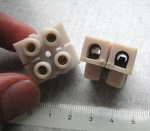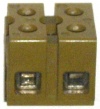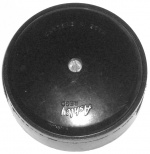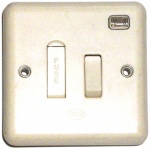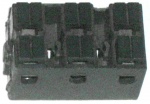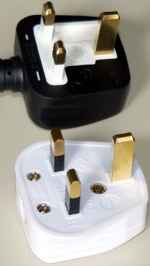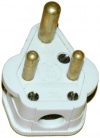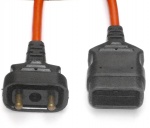Difference between revisions of "Electrical connection"
(Jelly, clear up) |
|||
| (12 intermediate revisions by the same user not shown) | |||
| Line 6: | Line 6: | ||
Often called chocolate blocks, (and seldom lustre conectors) these are the most popular [[cable]] connector in [[House Wiring for Beginners|fixed wiring]]. | Often called chocolate blocks, (and seldom lustre conectors) these are the most popular [[cable]] connector in [[House Wiring for Beginners|fixed wiring]]. | ||
| − | The main weakness of these is that they can sometimes loosen in time, creating a [[fire]] risk. This makes them [[Regulations|forbidden]] for inaccessible locations, such as under [[tiling]] etc. Also many screw connectors are found that haven't been tightened up enough, creating reliability and fire risks. (Connector failure due to overtightening is far less common.) | + | The main weakness of these is that they can sometimes loosen in time, creating a [[fire]] risk. This makes them [[Regulations|forbidden]] for inaccessible locations, such as under [[tiling]] etc. Also many [[screw]] connectors are found that haven't been tightened up enough, creating reliability and fire risks. (Connector failure due to overtightening is far less common.) |
| − | There's a simple method to reduce this risk to some extent. The stripped conductor of both [[cables]] extends under both screws, so both cables are screwed down at 2 points. This can be done with the cables entering at opposite sides or both on the same side. Now a bad connection only occurs if both screws loosen. The bare cable ends aren't bent over. Make sure the bare ends don't stick out on the far side. Its generally only possible to get 2 cables into a connector used this way. | + | There's a simple method to reduce this risk to some extent. The stripped conductor of both [[cables]] extends under both screws, so both cables are screwed down at 2 points. This can be done with the cables entering at opposite sides or both on the same side. Now a bad connection only occurs if '''both''' screws loosen. The bare cable ends aren't bent over. Make sure the bare ends don't stick out on the far side. Its generally only possible to get 2 cables into a connector used this way. |
| − | Wrapping screw blocks with [[Tapes|insulting tape]] is not adequate. It provides no fire protection, and tends to fall off. The wiring | + | Wrapping screw blocks with [[Tapes|insulting tape]] is not adequate. It provides no [[fire]] protection, and tends to fall off. The wiring [[regulations]] require a self extinguishing container for all fixed wiring junctions. Taped blocks are ok inside such containers, such as a junction box, [[pattress]] box or ceiling rose, but position them so they won't short to anything if the [[tape]] falls off, as it is prone to. |
[[Flex]] ends need twisting and folding over before use, and should not go in the same hole as [[cable]], or the flex connection can be weak and electrically inadequate. Lone cables going into a connector terminal are bent double to ensure good grip. | [[Flex]] ends need twisting and folding over before use, and should not go in the same hole as [[cable]], or the flex connection can be weak and electrically inadequate. Lone cables going into a connector terminal are bent double to ensure good grip. | ||
| − | Occasionally wire is damaged by the screw, and a very weak connection results. Its also possible for the screw to push flex strands out. Connector blocks are available with an extra flap under the screw (2nd & 3rd pics), which don't suffer this issue. | + | Occasionally wire is damaged by the [[screw]], and a very weak connection results. Its also possible for the screw to push flex strands out. Connector blocks are available with an extra flap under the screw (2nd & 3rd pics), which don't suffer this issue. |
| + | |||
===Junction box=== | ===Junction box=== | ||
[[image:Jbox ashley 20A 4933-2.jpg|right|150px]] | [[image:Jbox ashley 20A 4933-2.jpg|right|150px]] | ||
| − | Very popular in fixed wiring, these are [[screw]] connections | + | Very popular in fixed wiring, these are usually [[screw]] connections in a self extinguishing enclosure. Rotating the lid exposes a varying number of entry holes. |
The connection [[screw]]s often screw into a split hollow metal insert, which is in turn restrained by the plastic housing around it. If screwed too tight the hollow metal part can split apart, creating an unsafe connection. Some junction boxes use a better terminal design. | The connection [[screw]]s often screw into a split hollow metal insert, which is in turn restrained by the plastic housing around it. If screwed too tight the hollow metal part can split apart, creating an unsafe connection. Some junction boxes use a better terminal design. | ||
| − | The wiring [[regulations]] require junction boxes to be fixed in place, and [[cable|wires]] entering them to either be clipped, or secured in the box with a cordgrip. The lack of cord grip on most junction boxes makes them unsuitable for wires that aren't clipped in place. Plenty of fixed wiring exists that fails to comply on | + | The wiring [[regulations]] require junction boxes to be fixed in place, and [[cable|wires]] entering them to either be clipped, or secured in the box with a cordgrip. The lack of cord grip on most junction boxes makes them unsuitable for wires that aren't clipped in place. Plenty of fixed wiring exists that fails to comply on these points. |
| + | |||
| + | A variety of jboxes now exist that use other connection types. Some have cordgrips, some are suitable for inaccessible locations, and all are premium price products. Useful when later access is impractical. | ||
| Line 32: | Line 35: | ||
===FCU=== | ===FCU=== | ||
| + | [[image:1970s FCU 5015-3.jpg|150px|right]] | ||
| + | |||
An FCU (fused connection unit) does more than just connect wires together. They're used where a [[fuse]] and cordgrip are needed, ie when connecting an appliance [[flex]] to fixed wiring. | An FCU (fused connection unit) does more than just connect wires together. They're used where a [[fuse]] and cordgrip are needed, ie when connecting an appliance [[flex]] to fixed wiring. | ||
===Pushfit Connector=== | ===Pushfit Connector=== | ||
| − | After a long history of use inside [[lighting]] fittings, these are becoming more popular for higher current [[cable]] junctions now. These have been widely used for years in America, and don't have a great record for safety or reliability at the current levels used by sockets. They're quicker to use than choc blocks, are permitted in inaccessible locations, and a [[tool]] is only needed when releasing the wires. | + | After a long history of use inside [[lighting]] fittings, these are becoming more popular for higher current [[cable]] junctions now. These have been widely used for years in America, and don't have a great record for safety or reliability at the higher current levels used by sockets. They're quicker to use than choc blocks, are permitted in inaccessible locations, and a [[tool]] is only needed when releasing the wires. |
The bare [[cable]] end needs to be straight. Wago pushfit connectors are half the size per way of lever connectors. Pushfit can't use [[Flex|stranded wire]]. Ashley make pushfit junction boxes with cordgrips. | The bare [[cable]] end needs to be straight. Wago pushfit connectors are half the size per way of lever connectors. Pushfit can't use [[Flex|stranded wire]]. Ashley make pushfit junction boxes with cordgrips. | ||
| Line 60: | Line 65: | ||
[[image:RedCrimp.jpg|50px|right]] | [[image:RedCrimp.jpg|50px|right]] | ||
| − | [[Crimp]]ing makes a connection reliable enough to be permanently buried. A good crimping tool is needed. See [[crimp]]. | + | [[Crimp]]ing makes a connection reliable enough to be permanently buried. A good crimping tool is needed, cheap non-ratchet pliers don't make an acceptable joint. See [[crimp]]. |
| + | ===Jelly Connectors=== | ||
| + | [http://www.tlc-direct.co.uk/Main_Index/Telephones_and_Accessories_Index/Jelly_Crimp/index.html%23Jelly_Crimp&sa=D&sntz=1 pic] Gel filled single IDC connectors for outdoor use. Some don't have the gel. | ||
===Soldering=== | ===Soldering=== | ||
| − | Soldered joints are permitted in both accessible and inaccessible locations. Practically you need to provide some sort of strain relief for the joint, as solder is very weak. The cable ends should always be twisted together before soldering, otherwise even very small movements during assembly can cause the bond to fracture. Twist at least a couple of full turns, otherwise some movement can still occur, and the joint break. | + | Soldered joints are permitted in both accessible and inaccessible locations. Practically you need to provide some sort of strain relief for the joint, as solder is very weak. The [[cable]] ends should always be twisted together before soldering, otherwise even very small movements during assembly can cause the bond to fracture. Twist at least a couple of full turns, otherwise some movement can still occur, and the joint break. |
| − | Soldering isn't a popular option for fixed wiring because of these issues, and because soldering takes | + | Soldering isn't a popular option for fixed wiring because of these issues, and because soldering takes some equipment and skill. There's also no readily available junction box designed for soldering. Its a good enough option if you've got the skill to do the job properly, but if not, other joint types would be better. |
Wire needs to be spotlessly [[Cleaning|clean]] to solder, making soldering old [[cable]] a slow process. | Wire needs to be spotlessly [[Cleaning|clean]] to solder, making soldering old [[cable]] a slow process. | ||
| Line 83: | Line 90: | ||
__ wire follows a circular path | __ wire follows a circular path | ||
| − | /__\ wrapping round the cordgrip | + | /__\ wrapping round the cordgrip, |
______\__/_____ going under it twice | ______\__/_____ going under it twice | ||
| Line 89: | Line 96: | ||
| − | ===Round pin plugs=== | + | ===Bootlace ferrule=== |
| + | See Mains plugs section above | ||
| + | |||
| + | |||
| + | ===Round pin plugs, BS546=== | ||
[[image:BS-546-3-pin-plugs-4.jpg|100px|right]] | [[image:BS-546-3-pin-plugs-4.jpg|100px|right]] | ||
| − | Available in 2A, 5A and 15A sizes, these historic plugs are still used on [[lighting]] circuits to enable a wallswitch to control plug-in lamps. Both 2A and 5A plugs can be used on 5A and 6A lighting circuits, assuming the intended loads are within the plug's rating. 13A sockets aren't permitted on a 6A lighting circuit, as overloads would often occur in practice. | + | Available in 2A, 5A and 15A sizes, these historic plugs are still used on [[lighting]] circuits to enable a wallswitch to control plug-in lamps. Both 2A and 5A plugs can be used on 5A and 6A lighting circuits, assuming the intended loads are within the plug's rating. 13A sockets aren't permitted on a 5 or 6A lighting circuit, as overloads would often occur in practice. |
Round pin sockets used for mains must be shuttered, something that the original version of BS546 didn't address, so unshuttered sockets also exist. | Round pin sockets used for mains must be shuttered, something that the original version of BS546 didn't address, so unshuttered sockets also exist. | ||
| + | |||
| + | Its not normally desired to reinstall historic BS546 sockets, but it can be done with caveats for specialist work, museums etc. They need to be cleaned & checked thoroughly to ensure they're in sound condition, the socket is shuttered, switch contacts are clean and sprung and can't sit halfway on, that plugs can't be inserted into only 2 holes at an angle, there no carbon tracks, and that overheating doesn't occur at rated current. | ||
| + | * Heating is often solvable by cleaning up the contact surfaces. | ||
| + | * Carbon tracking on the rear can often be cut out | ||
| + | * Switches that sit partway on are sometimes resolved by cleaning out, and sometimes with just a trace of petroleum jelly | ||
| Line 101: | Line 117: | ||
These oval connectors are a good way to extend [[flex]]. They incorporate screw connections & cordgrips in a robust insulating case. | These oval connectors are a good way to extend [[flex]]. They incorporate screw connections & cordgrips in a robust insulating case. | ||
| + | |||
| + | Switched versions are often used on table lamps, and can also be used to extend [[flex]]es. | ||
===In-line plug & socket=== | ===In-line plug & socket=== | ||
| + | [[image:Mower connector 5027-3.jpg|150px|right]] | ||
| + | |||
These low profile plugs & sockets come in pairs and are used to extend [[flex]]es and provide a local disconnection point. Mostly used with outdoor [[power tool]]s, but can be used elsewhere. | These low profile plugs & sockets come in pairs and are used to extend [[flex]]es and provide a local disconnection point. Mostly used with outdoor [[power tool]]s, but can be used elsewhere. | ||
| − | They come in 2 and 3 pin versions. 2 pin connectors must not be used on 3 core appliances. There are also a few different pin configurations that have seen popular use over the years, so not all connectors are compatible with others. Many such connectors are rated at 5A, | + | They come in 2 and 3 pin versions. 2 pin connectors must not be used on 3 core appliances. There are also a few different pin configurations that have seen popular use over the years, so not all connectors are compatible with others. Many such connectors are only rated at 5A, a 5A connector is good for a 1kW motor. |
It shouldn't need saying, but what a world... ALWAYS connect the plug with sticking out pins to the [[appliance]], and the socket to the [[flex]] with the mains plug. | It shouldn't need saying, but what a world... ALWAYS connect the plug with sticking out pins to the [[appliance]], and the socket to the [[flex]] with the mains plug. | ||
| Line 118: | Line 138: | ||
===Resin filled capsule=== | ===Resin filled capsule=== | ||
| − | If a mains [[cable]] needs to be [[Taking electricity outside|joined underground]], the joint must be totally waterproof long term. The only realistic way to achieve this is to place the connection in a plastic housing, and fill it with [[Adhesive|resin]]. Suitable resin filled connector kits are available. Underground electricity distribution uses the same connectors | + | If a mains [[cable]] needs to be [[Taking electricity outside|joined underground]], the joint must be totally waterproof long term. The only realistic way to achieve this is to place the connection in a plastic housing, and fill it with [[Adhesive|resin]]. Suitable resin filled connector kits are available. Underground electricity distribution uses the same connectors in a larger size. |
===Wirenuts=== | ===Wirenuts=== | ||
| − | [[image:Wire_nuts-3.jpg|right|50px]] | + | [[image:Wire_nuts-3.jpg|right|50px|Wirenut]] |
These are little plastic or ceramic thimble-like items with a tapered hollow coarse screw thread on the inside. The [[cable]]s are pushed in and the wirenut rotated to screw it onto the cables. As it screws up, the conical screw thread presses the [[cable]]s together. | These are little plastic or ceramic thimble-like items with a tapered hollow coarse screw thread on the inside. The [[cable]]s are pushed in and the wirenut rotated to screw it onto the cables. As it screws up, the conical screw thread presses the [[cable]]s together. | ||
| − | These have been illegal to install on fixed mains wiring since the 1950s for safety reasons. They're seldom seen here now (but the US still uses them). | + | These have been illegal to install on fixed mains wiring since the 1950s for safety reasons. They're seldom seen here now (but the US still uses them). |
| + | |||
| + | |||
| + | ===Wirenut style crimps=== | ||
| + | [[image:Crimp wirenut type 5000-3.jpg|right|110px|Crimp connection]] | ||
| + | |||
| + | Crimped connections with a cover that looks like a wirenut are used inside some [[appliance]]s, these are safe. | ||
===Twist & tape=== | ===Twist & tape=== | ||
| Line 132: | Line 158: | ||
A variant on this used in the 1930s was the tobacco tin junction box. The wires inside were simply twisted together. Filling the tin with [[bitumen]] solved the wire oxidation issue and provided a cordgrip. However twisted connections have much higher resistance than the rest of the wire, so the joints were prone to getting hot enough to melt the flammable bitumen and expose the joint to oxidation. These are rarely seen today, and if spotted indicate a seriously substandard installation. | A variant on this used in the 1930s was the tobacco tin junction box. The wires inside were simply twisted together. Filling the tin with [[bitumen]] solved the wire oxidation issue and provided a cordgrip. However twisted connections have much higher resistance than the rest of the wire, so the joints were prone to getting hot enough to melt the flammable bitumen and expose the joint to oxidation. These are rarely seen today, and if spotted indicate a seriously substandard installation. | ||
| + | |||
| + | |||
| + | ===Whipped=== | ||
| + | [[image:1882 wiring rules joint.jpg|150px|right]] | ||
| + | |||
| + | If you ever find a whipped joint like this, its time to consider modernising. These were recommended in the first edition of the [[Electrical regulations|wiring rules]], in 1882. | ||
Latest revision as of 00:15, 15 December 2013
Screw connector blocks
Often called chocolate blocks, (and seldom lustre conectors) these are the most popular cable connector in fixed wiring.
The main weakness of these is that they can sometimes loosen in time, creating a fire risk. This makes them forbidden for inaccessible locations, such as under tiling etc. Also many screw connectors are found that haven't been tightened up enough, creating reliability and fire risks. (Connector failure due to overtightening is far less common.)
There's a simple method to reduce this risk to some extent. The stripped conductor of both cables extends under both screws, so both cables are screwed down at 2 points. This can be done with the cables entering at opposite sides or both on the same side. Now a bad connection only occurs if both screws loosen. The bare cable ends aren't bent over. Make sure the bare ends don't stick out on the far side. Its generally only possible to get 2 cables into a connector used this way.
Wrapping screw blocks with insulting tape is not adequate. It provides no fire protection, and tends to fall off. The wiring regulations require a self extinguishing container for all fixed wiring junctions. Taped blocks are ok inside such containers, such as a junction box, pattress box or ceiling rose, but position them so they won't short to anything if the tape falls off, as it is prone to.
Flex ends need twisting and folding over before use, and should not go in the same hole as cable, or the flex connection can be weak and electrically inadequate. Lone cables going into a connector terminal are bent double to ensure good grip.
Occasionally wire is damaged by the screw, and a very weak connection results. Its also possible for the screw to push flex strands out. Connector blocks are available with an extra flap under the screw (2nd & 3rd pics), which don't suffer this issue.
Junction box
Very popular in fixed wiring, these are usually screw connections in a self extinguishing enclosure. Rotating the lid exposes a varying number of entry holes.
The connection screws often screw into a split hollow metal insert, which is in turn restrained by the plastic housing around it. If screwed too tight the hollow metal part can split apart, creating an unsafe connection. Some junction boxes use a better terminal design.
The wiring regulations require junction boxes to be fixed in place, and wires entering them to either be clipped, or secured in the box with a cordgrip. The lack of cord grip on most junction boxes makes them unsuitable for wires that aren't clipped in place. Plenty of fixed wiring exists that fails to comply on these points.
A variety of jboxes now exist that use other connection types. Some have cordgrips, some are suitable for inaccessible locations, and all are premium price products. Useful when later access is impractical.
Pattress box
A backbox and blanking plate plus a screw connector strip can be used like a junction box with lots of ways. Like junction boxes they normally lack a cord grip, though backboxes with cordgrips are available. Useful as a central heating wiring centre, and for complex flexible house wiring schemes.
FCU
An FCU (fused connection unit) does more than just connect wires together. They're used where a fuse and cordgrip are needed, ie when connecting an appliance flex to fixed wiring.
Pushfit Connector
After a long history of use inside lighting fittings, these are becoming more popular for higher current cable junctions now. These have been widely used for years in America, and don't have a great record for safety or reliability at the higher current levels used by sockets. They're quicker to use than choc blocks, are permitted in inaccessible locations, and a tool is only needed when releasing the wires.
The bare cable end needs to be straight. Wago pushfit connectors are half the size per way of lever connectors. Pushfit can't use stranded wire. Ashley make pushfit junction boxes with cordgrips.
- Wago connectors
- Ashely pushfit JB with cord grip
- Ashely pushfit JB with cord grip
- Wago connectors at TLC direct
Lever connectors
The cable is clamped on these by pushing a lever down. Levers connectors are handy for temporary connections. Stranded wire works in lever connectors. If more than one wire is used in each entrance hole, they need to be identically sized, and check both are properly secured.
Pushbutton connector
These are sprung shut, and use a pushbutton to release the clamping force on the cable. These are good for flex as well as cable.
Wago 224 is a variant of this type. Cables can be pushed in, or the connector is pressed open for flex.
Crimps
Crimping makes a connection reliable enough to be permanently buried. A good crimping tool is needed, cheap non-ratchet pliers don't make an acceptable joint. See crimp.
Jelly Connectors
pic Gel filled single IDC connectors for outdoor use. Some don't have the gel.
Soldering
Soldered joints are permitted in both accessible and inaccessible locations. Practically you need to provide some sort of strain relief for the joint, as solder is very weak. The cable ends should always be twisted together before soldering, otherwise even very small movements during assembly can cause the bond to fracture. Twist at least a couple of full turns, otherwise some movement can still occur, and the joint break.
Soldering isn't a popular option for fixed wiring because of these issues, and because soldering takes some equipment and skill. There's also no readily available junction box designed for soldering. Its a good enough option if you've got the skill to do the job properly, but if not, other joint types would be better.
Wire needs to be spotlessly clean to solder, making soldering old cable a slow process.
Mains plugs
Soldered wires should not be put into screw connections, the 2 aren't a safe combination. The first problem is that solder is soft and tends to creep under screw pressure, leaving a weakly clamped joint after a while. The other is that the soldering of stranded wire makes strands more likely to break. Soldering screwed wires increases the odds of fault & fire.
Crimped flex ends can be safely used in mains plugs and other screw connectors. Ideally the flex should be twisted before the bootlace ferrule is applied, to avoid concentrating stresses on a small number of strands.
A small number of old mains plugs use screw connections where the flex goes under the screw head and around the screw shank. There is a tendency for these screws to push strands out when tightened, and too often most of the strands end up not connecting. Make the stripped flex end long enough to go nearly all the way round the screw shank, and twist the strands fairly tightly to minimise strand pushout. A small washer under the screw head also minimises the problem.
Small diameter flexes and some cordgrip designs result in the plug cordgrip failing to grip the flex. This can be remedied by putting the flex 360 degrees round the cordgrip before tightening, like so:
__ wire follows a circular path
/__\ wrapping round the cordgrip,
______\__/_____ going under it twice
If using 13A plugs & sockets outdoors, its wise to use unbreakable ones. Brittle indoor sockets are soon broken outdoors.
Bootlace ferrule
See Mains plugs section above
Round pin plugs, BS546
Available in 2A, 5A and 15A sizes, these historic plugs are still used on lighting circuits to enable a wallswitch to control plug-in lamps. Both 2A and 5A plugs can be used on 5A and 6A lighting circuits, assuming the intended loads are within the plug's rating. 13A sockets aren't permitted on a 5 or 6A lighting circuit, as overloads would often occur in practice.
Round pin sockets used for mains must be shuttered, something that the original version of BS546 didn't address, so unshuttered sockets also exist.
Its not normally desired to reinstall historic BS546 sockets, but it can be done with caveats for specialist work, museums etc. They need to be cleaned & checked thoroughly to ensure they're in sound condition, the socket is shuttered, switch contacts are clean and sprung and can't sit halfway on, that plugs can't be inserted into only 2 holes at an angle, there no carbon tracks, and that overheating doesn't occur at rated current.
- Heating is often solvable by cleaning up the contact surfaces.
- Carbon tracking on the rear can often be cut out
- Switches that sit partway on are sometimes resolved by cleaning out, and sometimes with just a trace of petroleum jelly
Flex connector
These oval connectors are a good way to extend flex. They incorporate screw connections & cordgrips in a robust insulating case.
Switched versions are often used on table lamps, and can also be used to extend flexes.
In-line plug & socket
These low profile plugs & sockets come in pairs and are used to extend flexes and provide a local disconnection point. Mostly used with outdoor power tools, but can be used elsewhere.
They come in 2 and 3 pin versions. 2 pin connectors must not be used on 3 core appliances. There are also a few different pin configurations that have seen popular use over the years, so not all connectors are compatible with others. Many such connectors are only rated at 5A, a 5A connector is good for a 1kW motor.
It shouldn't need saying, but what a world... ALWAYS connect the plug with sticking out pins to the appliance, and the socket to the flex with the mains plug.
A standard 13A plug and socket is more versatile, enabling a (3 core only) lead to be used on any appliance. But its bulkier.
Chocbox
This is a tradename for a plastic box for use with choc block connectors. It has cord grips and a snap shut lid.
Resin filled capsule
If a mains cable needs to be joined underground, the joint must be totally waterproof long term. The only realistic way to achieve this is to place the connection in a plastic housing, and fill it with resin. Suitable resin filled connector kits are available. Underground electricity distribution uses the same connectors in a larger size.
Wirenuts
These are little plastic or ceramic thimble-like items with a tapered hollow coarse screw thread on the inside. The cables are pushed in and the wirenut rotated to screw it onto the cables. As it screws up, the conical screw thread presses the cables together.
These have been illegal to install on fixed mains wiring since the 1950s for safety reasons. They're seldom seen here now (but the US still uses them).
Wirenut style crimps
Crimped connections with a cover that looks like a wirenut are used inside some appliances, these are safe.
Twist & tape
Much used in the past, twisting wires together and taping them is a recipe for fire. The UK has around 69,000 domestic fires a year, killing over 400 people. One problem stems from the fact that such joints aren't gas tight, so the copper oxidises in time, creating resistance in the joint. This causes heating, causing more oxidation and resistance, causing more heating and fire.
A variant on this used in the 1930s was the tobacco tin junction box. The wires inside were simply twisted together. Filling the tin with bitumen solved the wire oxidation issue and provided a cordgrip. However twisted connections have much higher resistance than the rest of the wire, so the joints were prone to getting hot enough to melt the flammable bitumen and expose the joint to oxidation. These are rarely seen today, and if spotted indicate a seriously substandard installation.
Whipped
If you ever find a whipped joint like this, its time to consider modernising. These were recommended in the first edition of the wiring rules, in 1882.
